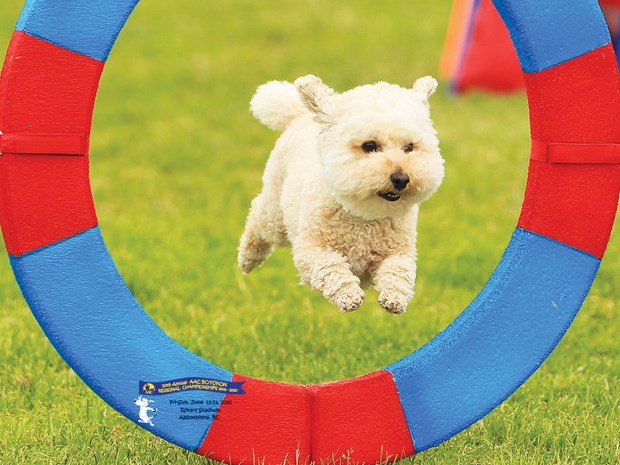When Elizabeth Dung got her first puppy she learned quickly that Jojo, a Cockerpoo, was born with some strange health and mental issues.
The Cocker Spaniel mixed poodle starved himself unless coerced to eat, a leaf falling to the ground was enough to spook him, and he was nervous being around other dogs and people, preferring to hide from them. A puppy school instructor told Dung that she had a problematic puppy who would need a lot of work to get over his issues.
Shortly after learning about Jojo’s problems, Dung got a second dog, Kiki, a Maltipoo (Maltese mixed poodle). She hoped this would help Jojo become more social, but it didn’t work. After a year of attending obedience school, which also didn’t help Jojo’s condition, the instructor recommended they do agility training to build his confidence.
That was 10 years ago and since then Jojo has won three BC/Yukon Dog Agility Regional Championships.
“I didn’t think I would ever be doing this,” Dung said. “In the beginning, I just wanted him to eat and not be so scared; that was the original idea.”
Once a form of entertainment, agility started in the 1970s at the Crufts dog show in England. It soon grew into a competitive, timed sport which involves a dog going through an obstacle course, taking direction from their owner. Dog agility was introduced into Canada in 1988.
The obstacle course involves jumping through a suspended tire, running through tunnels, on planks and see-saws.
A course can easily have 20 or more obstacles and a whole circuit should take less than a minute.
There are different categories, based on the size and age of the dog and obstacles are adjusted for those variations.
“There are some super competitive people who take this seriously, but I’m not as competitive,” Dung said. “I do it because it’s a lot of fun.”
Kiki, described as a “happy-go-lucky dog,” also competed and placed sixth in a national competition once.
She suffered a disc injury last Christmas, not related to agility training, so she is now retired from the sport. Dung’s third dog, a two-year-old toy poodle named Brownie is also competing.
“It’s so addictive,” Dung said about agility, adding that training and going to various workshops has cost her a small fortune. “In order to get that blue ribbon (first place), I spent thousands of dollars.”
“All agility people are broke,” Dung added with a laugh.
Dung will compete with Jojo at the Agility Association of Canada National’s competition, to be held at Burnaby’s Swangard Stadium from Aug. 19 to 23. More than 500 dogs will compete in the event which attracts participants from throughout Canada, United States and Europe.
“It’s a growing sport and when people try it, they find out how fun it is so they continue on,” AAC spokesperson Sonya Bosecke said. “You’re challenging yourself and you’re challenging your dog.”
Agility allows people to really connect with their dogs as it develops a stronger trust and bond between the two, Bosecke explained, allowing them to work together as a team.
Admission to the AAC Nationals is free, but spectators are encouraged to bring a canned food donation for the food bank.
For more information, visit www.aac.ca.



